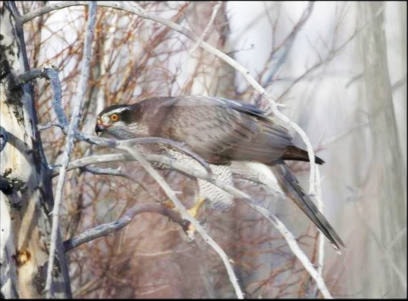The Northern Goshawk is a powerful raven-sized forest raptor that was once common in the Lakes District and across much of British Columbia. During the land use planning initiatives that took place some 15-20 years ago this bird was viewed as an umbrella species for ecosystem health.
A healthy goshawk population was seen as indicative of a robust ecosystem, through the abundance of forest birds and mammals that they relied upon for food, and the old forest structure that provided for their nest sites.
Since the mid 1990’s, collaborative research found that pairs of birds were regularly spaced across the landscape, with pairs found every 4-5 kilometres.
We found their large stick nests placed beneath the canopy within large patches of old lower elevation forests, and these nest sites were used for many decades. We learned the same from radio tagging some birds. We also observed that they hunted in mature – old growth stands, and that they avoided large clear-cut areas.
But about five years ago we noticed fewer and fewer birds. Over the intervening years, at the request of licensees and the government, we systematically surveyed goshawk nests for any signs of recent occupation. In the 36 local areas surveyed, we found that nobody was home. Across the larger region (From Terrace to Fraser Lake) we have now resurveyed more than 100 known goshawk nest sites and 90 per cent are abandoned.
Our research - and comparable work in other parts of North America - has found that nests that support breeding are primarily found in intact mature forest landscapes. Within our landscape a tipping point may have been reached.
If there is more young forest than old forest in goshawk territory, then it appears that it can no longer support breeding birds, and when these adult birds eventually die there are no young to replace them.
Over the last 30 years, the rate of timber harvests, the mountain pine beetle epidemic, catastrophic fires and a changing climate have left a patchwork landscape with more younger forest.
Earlier and warmer spring temperatures might also be producing earlier hatching of blackflies, resulting in swarms of the insects killing many nestlings.
Maybe we can’t do anything about the black flies, but can we find a way to harvest differently so that we can maintain suitable goshawk territories? Can we identify and protect large enough goshawk areas that also overlap with multiple other forest values (caribou, moose, grizzly bears, trap lines, berry patches, etc.)? That is the challenge we face.
We need to find as many birds and active nests as possible, and invite the public to report back if the birds are seen or heard. It is hoped we can protect their nests. Goshawks are drawn to chicken coops, so knowing how few birds there are please ensure the goshawks are unharmed.
Please contact Frank Doyle if you see or hear these birds. Email: wildlifedynamics@gmail.com Cell: 250 643 2870.
